Macroeconomics Assignment On Eurozone Economy
Question
Task:
Write a report that assess the role of the Eurozone institutions to achieve macroeconomic goals.
The report should include the following sections:
• Cover Page: Title, Course, Name of Student
• Table of Contents
• Section 1. (25%) The Eurogroup is debating EU-wide unemployment insurance scheme.
o Define the different types of unemployment and discuss which one is the target of such a measure. o Analyze the possible effects of this measure using the concepts delivered in class.
• Section 2. (25%) Monetary authorities.
o In the Eurozone, which institution oversees monetary policy, and which one controls fiscal policy?
The main goal of the European Central Bank is controlling the inflation. Why it is so important? To answer this question: o define aggregate demand and aggregate supply in the long-run and short-run (use graphs), and
o explain the main effects of rising prices in the economy using the concepts delivered in class.
• Section 3. (25%) During the 2008 crisis, the Eurozone countries applied different strategies to prevent a fall of aggregate demand.
o Provide two examples of fiscal policies in face of an economic crisis and discuss their positive and negative effects on aggregate demand. Use the concepts of
“multiplier effect” and “crowding-out effect” delivered in class.
• Section 4. (25%) There is evidence of an increasing protectionism in global trade (US and China trade war), which might cause a fall in global trade.
o Explain what the expected impact of the fall in international trade on the Eurozone economy might be. Use the AD/AS model and the concepts delivered in unit
8. This section must include a written explanation and charts.
• Bibliography
Answer
Introduction
The present study on macroeconomics assignment is based on the critical analysis and evaluation of the role of Eurozone institutions to attain macro-economic goals. It covers the debate of Eurogroup on the EU-wide unemployment insurance scheme, while also discussing the monetary policies. It also emphasises on the different strategies employed by Eurozone countries for avoiding fall of aggregate demand. Lastly, the study provided in the macroeconomics assignment ends with discussing the rising protectionism in global trade, which might cause a reduction in global trade.
Section 1
Different types of unemployment
Unemployment has been the most unmanageable and continuing problems faced by all industrial countries across the world. Simultaneously, the primary aim of public policy has been to eliminate unemployment to attain full employment in these countries (Fujita and Moscarini, 2017). The significant types of unemployment are discussed as below within this macroeconomics assignment:
- Frictional unemployment: It takes place when there is an insufficient adjustment between demand and supply of workers. It exists in an economy when individuals are in the process of moving from one job to other.
- Seasonal unemployment: This type of unemployment mentioned in the macroeconomics assignment occurs when individuals face unemployment mainly, at the time of year when there is lower demand for workers than usual.
- Cyclical unemployment: It is associated with the changes in unemployment because of o economic expansion as well as recessions (Bakker, Korczak and Krogulski, 2019).
- Structural unemployment: It is a type of unemployment that takes place from industrial re-organisation; it comes from a variety of reasons such as insufficient co-operant production factors, fluctuation in societal, economic structure etc.
- Technological unemployment: This unemployment emerges when technological development might cause labor to lose jobs.
- Disguised unemployment: It is a type of unemployment where higher amount of individuals in an activity, in case if some of them are removed the level of productivity still stays the same.
Discussion of the one which is target of such a measure and its potential impacts
Regardless of the potentially disruptive social as well as economic impact by the 2008-2013 European crises, the lowest profile was retained by unemployment. It can be stated in the context of macroeconomics assignment that structural, as well as cyclical unemployment (existing demand deficit), played a considerable part, and Europe has along struggled with continuing structural unemployment for the last twenty years. Furthermore, the higher unemployment rates mainly occurred due to inflexible labour market, geographicalimmobility, severe market regulation which demotivated organisations from making investments and hiring new workers, and liberal unemployment benefits which augmented frictional unemployment (Ghoshray, Ordóñez and Sala, 2016).
At the beginning of the crises, the initial steady increase in the euro era unemployment rate was propelled profoundly due to the rise in short term unemployment, at the time of the onset-job shedding stages of a recession. On the other hand, it is also clear on this macroeconomics assignment that as the crises emerged, the rates for finding job reduced noticeably resulting in longer unemployment predictions. From the perspective of policy, the apparent increment in the long-term unemployment has been the most labour market outcomes of the crises, since the predictions of extended unemployment might change into structural unemployment and thereby a noticeable fall in possible output in long-term. In this present context of macroeconomics assignment, there were slow but persistent falls in the outflow rate, which indicated that the recovery rate would be even slower (Schubert and Turnovsky, 2016). Therefore, the substantial rise in long-term unemployment, as well as measured skill mismatch, caused significant concerns associated with structural unemployment.
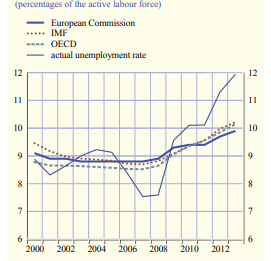
Figure 1: Estimation of the structural unemployment for the Euro Era
(Source: European Central Bank, 2018)
Section 2 of macroeconomics assignment
Institution overseeing monetary policy
In the Eurozone, the European Central Bank (ECB) oversees and manages the euro, and adopts the European Union economic and monetary policy (Hartmann and Smets, 2018). Most of the EU’s member states took participation in the economic and monetary union (EMU) based on euro currency;therefore, the European Union members controlled the fiscal policy in Eurozone.
What is the importance of controlling inflation by the European Central Bank and the impacts of rising prices on the economy discussed in the macroeconomics assignment?
As per the studies considered to prepare this macroeconomics assignment, the long-run Aggregate Supply is a vertical line at the possible output level. The intersection of the AD of the economy and the long-run AS curve identifies its equilibrium actual GDP and level of price in the long run (Seeley, 2017)). In the long run, the AS curve and AD curve are only impacted by technology, capital and labour. In the short run, either the output is lower or higher than the potential output. The AD model and long-run AS estimate that the economy would ultimately even more towards its possible output.
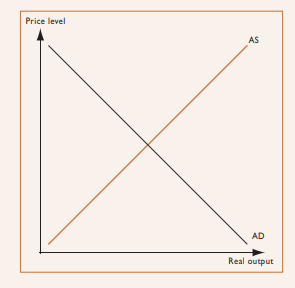
Figure 2: Short-run equilibrium
(Source: European Central Bank, 2009)
In this way, it can be discussed herein macroeconomics assignment that in the short run, the Central Bank would raise the interest rate for moderating the inflation rate, a higher rate of inflation could result into increased uncertainty among business resulting intolower investment, it might also lead to depreciation in the exchange rate.
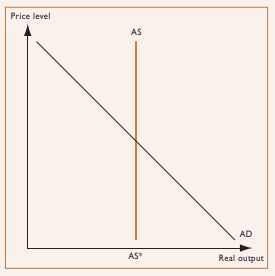
Figure 3: Long-run equilibrium
(Source: European Central Bank, 2009)
As per the long run, the conduct of AD is critical in identifying the standard price level that is experienced by the economy in the long run. If the AS curve is vertical, fluctuation in AD will impact the prices, not the output. Thus, a process of inflation can only be raised by a persistent rise in AD over time. This, in exchange, can only take place if the monetary policy lodge such growth by retaining interest rate slower and growth of money higher (Mendicino and et al. 2019).
The main objective of the European Central Bank outlined in the macroeconomics assignment is to control the inflation it is imperative,as huge erosions of actual wealth and income because of high inflation can be a source of political inconsistency and social unrest. Overall, by managing price stability, the central bank assists wider economic goals to be attained, therefore making contributing to the standard political stability (Claeys and Demertzis, 2017). The ECB needs to control the inflation rate, and if not, then it can raise the prices drastically. It can impact the firm, workers, customer, savers as a whole. A rise in inflation can lead to high costs of raw materials; on the other hand, workers are more expected to demand higher wages to address with a high living cost. This price rise can also lead to higher volatility and uncertainty (Claeys, Demertzis and Mazza, 2018).In addition to this, with the rising prices, a customer might be more inclined to purchase on a panic basis,assuming that price would increase further. Moreover, higher rates of interest would also increase borrowing costs and reduce the investment rate and slower economic growth. Eventually, reduced economic growth would result in demand-pull inflation. Thus, if the inflation increase more than the target, they banks would increase the interest rate which can make the economic condition worse, as declining growth, development and investment would be evidenced (Christelis and et al. 2020). Therefore, the primary objective of the EC is to manage the price stability in the euro area, assisting the presence of the euro purchasing power.
Section 3
Examples of fiscal policy and the pros and cons of AD
The concept of Fiscal policy explored in this section of macroeconomics assignment is the mechanism by which a government makes an adjustment to its spending level as well as the taxes rate for monitoring and influencing the economy of the nation (Hansen, 2018).There were several fiscal policies and measures adopted in the face of 2008 economic crises. Fiscal authorities in the Euro Areas implemented the main two measures of; the baseline model by initiating the non-Richardian households in the form of rule-of-thumb customer, and second, the model was augmented by enabling for the non-separable valuable governmental assumption. In addition to this, asset purchases and forward guidance was conducted by central bank at the time of crises as shows in fig 7 in the Appendix section of macroeconomics assignment.
The positive impact of these models used at the 2008 crises was that the fluctuations in the government consumption impact the optimal decisions of private consumption on a direct basis, against the indirect wealth impact in the situation of separable government consumption. In addition to this, conditional on the scale of co-movement of government and private consumption might be attained (European Central Bank, 2012). However, the negative impact of the policies was that the government debt, expense, interest rates and deficits in the budget created a pessimistic impact on the private investment, on the other hand, the influence of economic growth is positive. The requirement to finance huge deficits, debt-roll over as well as bank rescue packages have made the governmental authorities exposed to rapid fluctuations in the market sentiments resulting in larger and longer-term interest rates. Therefore, this might pressure them to implement pro-cyclic preventive fiscal policies for restoring confidence. Further, the upward force on interest rates also threatensto crowd out of private investment with unfavourable impacts for potential development(Gechert, Hallett and Rannenberg, 2016).
The multiplier effect is considered a phenomenon wherein a specified fluctuation in a particular input, led to a larger fluctuation in output. This can be connected to the 2008 crises in a way that the discretionary fiscal policies that were used in the euro area resulted into the rise in annualisedquarterly GDP growth by 1.6 percentage points at the time of crises(European Central Bank, 2012).
Crowding-out-effect is considered as a phenomenon that takes place when higher government involvement in an industry of the market economy considerably impacting the remaining market, either on the demand and supply of the market. It can be cited in this macroeconomics assignment that crowding out effect can form critical interaction between growth, public debt holding, investment and default risk which were the main aspects of 208 crises. It is because the rises in spreads incite the local debt repurchasing that move productive investment and reduce the growth.
Section 4
Rising protectionism in global trade and the impact of fall in global trade on the Eurozone economy
It has been evidenced in this study of macroeconomics assignment that approximately half of the reduction in trade elasticity between the 2007 to 2013 period was because of compositional forces, i.e. the increasing weight in the world economy of emerging market nations, which have a reduced trade intensity as compared to the developed economies.
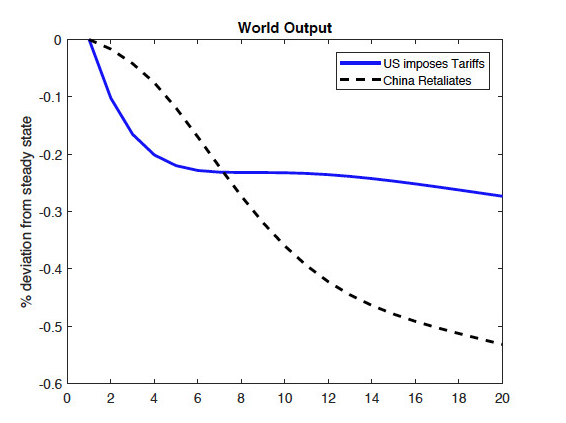
Figure 4: Impact on world output from US-China import tariffs
(Source: Bolt, Mavromatis and Wijnbergen, 2019)
Rising protectionism can impact the economic activity via various channels; increased import duties heighten trade costs which might change both quantities as well as the price of globally traded products. Moreover, the increased trade costs can impact the credit conditions as well as financial flows. This might take place, for unrest and full re-assessment of risk premia. In short-run, the increased import tariffs can enlarge the prices of the imported items for firms as well as households. Tothe international trade war, the global GDP impacts are based on the substitutability among local goods and imported goods (Berthou and et al. 2019).
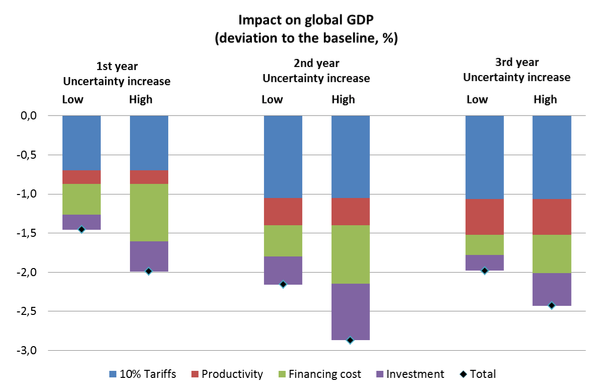
Figure 5: Impact on global GDP
(Source: Berthou and et al. 2019)
Moreover, the impacts due to rise in tariffs as shows in the fig 9 in appendix section of macroeconomics assignment, a trade war can also influence economies via various indirect ways, some of them are rise in financing capital costs because of financial unrest, reduction in investment due to rise in uncertainty over future business conditions leading organisations to wait and see, a reduction in productivity because of change in productive resource allocation throughout heterogeneous firmsinstance, in case higher uncertainty over the futuretradepolicy results into financial.
In addition to this, increased trade costs can also put weights on productivity, the severe financing conditions related with increasing uncertainty can increase the capital costs, with the pessimistic influence on investment that can obstruct productivity growth in nations impacted by tariffs (Park, 2020). Furthermore, it can be stated that trade barriers can also result in the mis-allotment of production forces throughout organisation and nations. In this way, the inactive markers reduce the international completion, thereof lowering incentives for innovation as well as technological advancement, retaining less productive firm in the marketplace (Harding and Harding, 2020). Consequently, aggregate productivity might fall. Therefore, it can be stated herein macroeconomics assignment that a reduction in international trade would reduce exports more than the reduction in imports, slowing net exports, which eventually reduce AD.
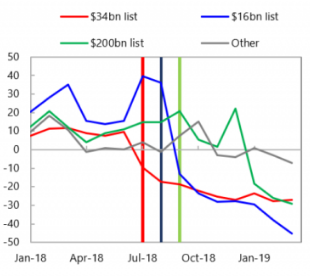
Figure 6: Drop of US imports from China
(Source: IMFBlog, 2019)
Conclusion
Based onthe above analysis done in the macroeconomics assignment, it can be concluded that unemployment during the Euro crises hit the economy so hard, impacting the output, recovery rate and overall economic growth. The Eurozone institutions have played a considerable role in attaining the macro-economic goals by persistent monitoring and influencing of inflation by implementing monetary and fiscal policies.
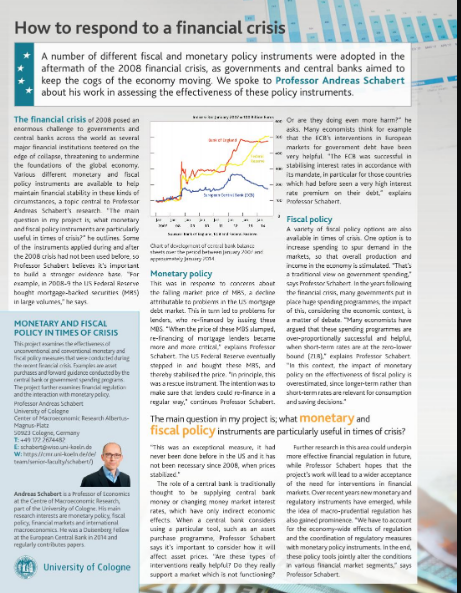
Appendix
Figure 7: The Fed and the 2008 financial crisis
(Source: ISSUU, 2019)
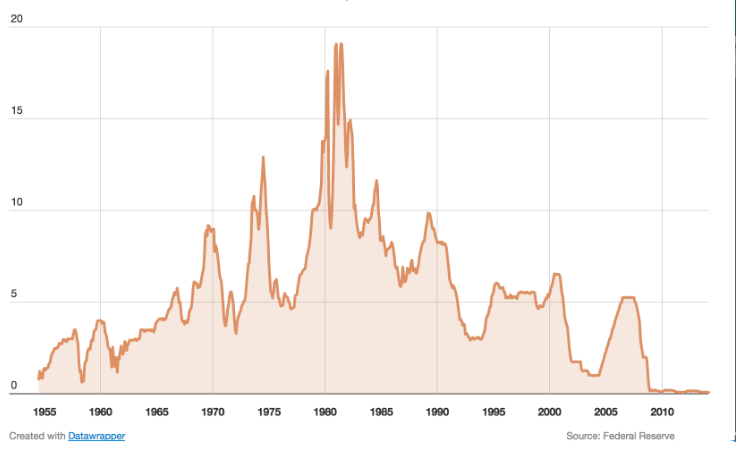
Figure 8: Federal funds rate
(Source: Yglesias, 2015)
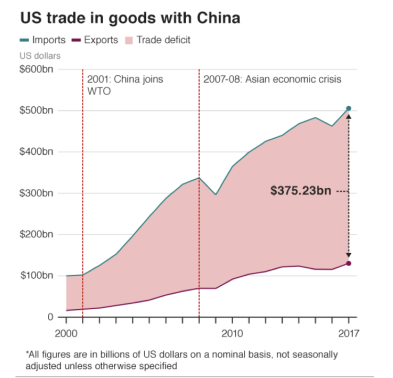
Figure 9: US-China Trade War Effect on the EU
(Source: ESCP Finance Society, 2019)
References
Bakker, M.B.B., Korczak, M. and Krogulski, M.K., 2019. Unemployment Surges in the EU: The Role of Risk Premium Shocks. macroeconomics assignment International Monetary Fund.
Berthou, A., Jardet, C., Siena, D. and Szczerbowicz, U., 2019. The macroeconomic implications of a global trade war. VoxEU. Org, 8.
Berthou,A., Jardet, C.,Siena, D., and Szczerbowicz, U., 2019. The macroeconomic implications of a global trade war(Online). Available from
Bolt, W., Mavromatis,K., and Wijnbergen, S, V., 2019. The global macroeconomics of a trade war: Findings from the EAGLE model (Online). Available from
Christelis, D., Georgarakos, D., Jappelli, T. and Van Rooij, M., 2020. Trust in the central bank and inflation expectation.
Claeys, G. and Demertzis, M., 2017. How should the European Central Bank ‘normalise’its monetary policy? (No. 2017/31). Bruegel Policy Contribution.
Claeys, G., Demertzis, M. and Mazza, J., 2018. A monetary policy framework for the European Central Bank to deal with uncertainty (No. 2018/21). Bruegel Policy Contribution.
ESCP Finance Society, 2019. US-China Trade War Effect on the EU (Online). macroeconomics assignment Available from
European Central Bank, 2009. PRI C E S TABI L I TY: WHY I S I T IMPORTANT FOR YOU? (pdf). Available from < https://www.ecb.europa.eu/pub/pdf/other/whypricestabilityen.pdf>.[Accessed on 16 May 2020].
European Central Bank, 2012. FISCAL POLICY AND THE GREAT RECESSION IN THE EURO AREA (pdf). Available from < file:///C:/Users/HP/Downloads/ecbwp1429.pdf].
European Central Bank, 2018. THE IMPACT of the ECONOMIC CRISIS ON EURO AREA LABOUR MARKETS (pdf). Available from
Fujita, S. and Moscarini, G., 2017. Recall and unemployment. American Economic Review, 107(12), pp.3875-3916.
Gechert, S., Hallett, A.H. and Rannenberg, A., 2016. Fiscal multipliers in downturns and the effects of Euro Area consolidation. Applied Economics Letters, 23(16), pp.1138-1140.
Ghoshray, A., Ordóñez, J. and Sala, H., 2016. Euro, crisis and unemployment: Youth patterns, youth policies?. Economic Modelling, 58, pp.442-453.
Hansen, A.H., 2018. Monetary theory and fiscal policy. Pickle Partners Publishing.
Harding, R. and Harding, J., 2020. Strategic Trade as a Means to Global Influence. macroeconomics assignment The Handbook of Global Trade Policy, pp.143-172.
Hartmann, P. and Smets, F., 2018. The European Central Bank’s Monetary Policy during Its First 20 Years. Brookings Papers on Economic Activity, 2018(2), pp.1-146.
IMFBlog, 2019. The Impact of US-China Trade Tensions (Online). Available from < https://blogs.imf.org/2019/05/23/the-impact-of-us-china-trade-tensions/>.
ISSUU, 2019. Monetary and fiscal policy in times of crisis (Online). Available from
Mendicino, C., Nikolov, K., Suarez, J. and Supera, D., 2019. Bank Capital in the Short and the Long Run. Journal of Monetary Economics.
Park, S.C., 2020. Protectionism as Challenges for Global Trade Governance. The Future of Global Economic Governance (pp. 87-100). Springer, Cham.
Schubert, S.F. and Turnovsky, S.J., 2016. 6 Endogenous growth and unemployment. Economic Theory and its History, p.65.
Seeley, K., 2017. Short-Run Aggregate Supply/Aggregate Demand and Policy. In Macroeconomics in Ecological Context (pp. 273-294). Springer, Cham.
Yglesias, M, 2015. The Fed and the 2008 financial crisis (Online). macroeconomics assignment Available from












